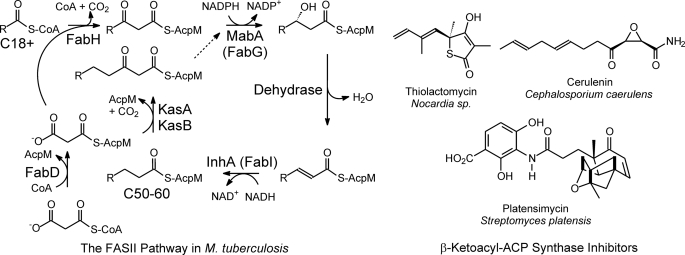FIGURE 1.
The FAS-II pathway in M. tuberculosis and the structures of several natural product KAS inhibitors. In M. tuberculosis, the FAS-II pathway elongates the C18+ acyl-CoAs from the FAS-I pathway to C54-C56 fatty acids. The pathway is primed by the CoA-dependent β-ketoacyl-AcpM synthase FabH, which condenses the acyl-CoA with malonyl-AcpM to generate a β-ketoacyl-AcpM. The β-ketoacyl-AcpM is converted into a saturated enoyl-AcpM by the sequential actions of a β-ketoacyl-AcpM reductase (MabA), a dehydrase, and a trans-2-enoyl-AcpM reductase (InhA). Subsequent rounds of elongation are initiated by the KasA or KasB β-ketoacyl-AcpM synthases. KasA is thought to be responsible for the early rounds of fatty acid elongation. Also shown is the malonyl-CoA AcpM transacylase (FabD) responsible for the synthesis of malonyl-AcpM. β-Ketoacyl-AcpM synthase inhibitors include the natural products thiolactomycin, cerulenin, and platensimycin.

